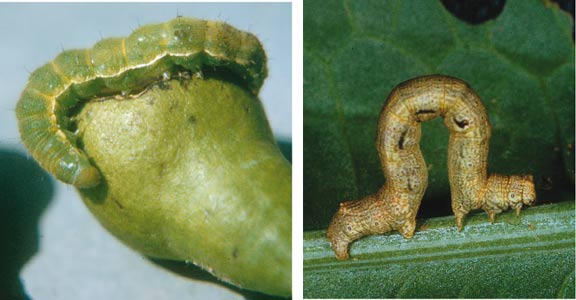Management of Helicoverpa and loopers involves a combination of weed management, biological control, entomopathogens, early season monitoring, and careful selection of pesticides to avoid disrupting predators and parasitoids that would otherwise manage to keep other pests below economic thresholds.
Management (cont from last issue)
The apple looper has a range of hosts, including acacia. Budworms feed on a wide range of weeds such as deadly nightshade, Noogoora burr, thistles, capeweed, dock, fat hen and marshmallow. Management of those weeds prior to flowering of pome fruit will not only reduce incidence of budworms but will also help reduce populations of LBAM and harlequin bugs.
However, this does not mean leaving bare earth in the inter row! Biological control agents such as parasitoid wasps require access to flowering plants for energy sources like sugar, so it is important to maintain a balance of plants in the inter row without promoting the weeds mentioned above.
Biological control
Several biological control agents actively work to control Helicoverpa and loopers.
Trichogramma wasps parasitise budworm eggs and probably also looper eggs.
The small black wasp Microplitis demolitor parasitises young budworm caterpillars.
The predatory shield bugs Cermatulus nasalis and Oechalia schellenbergii attack Helicoverpa and other caterpillars.
Green lacewing larvae, lynx spiders, and red and blue beetles are known to prey on budworms.
Small caterpillars can be controlled by applying sprays containing the entomopathogenic bacteria Bacillus thuringiensis (Bt). Once the larvae have grown beyond the third instar, they are probably beyond control by Bt alone and a registered chemical insecticide may be required. Choose carefully to minimise the impact on other biocontrol agents.
Monitoring
Monitoring for eggs during the fruit tree flowering period can be done at the same time you are doing blossom tapping to detect dimple bugs and thrips.
Small loopers may be dislodged into the container and if that occurs then it would be prudent to look for eggs and other small larvae among the flowers.
If the orchard is surrounded by pasture or field crops you may want to position some pheromone traps along the border to detect movement of moths into the orchard.
After petal fall the ‘one-minute tree inspection’ should be used to search for larval feeding activity.
Pears are particularly attractive to twig loopers and the first sign of activity is usually the presence of small cylindrical pellets of faecal matter on the upper surface of leaves. These leaves may not have been eaten but the larvae producing the pellets are likely to be detected feeding on leaves on twigs or branches above where the pellets were found.
Twig loopers are sensitive to movement and will become immobile while imitating a small twig (hence the name). Once you detect the pellets, stand quietly and do not make any sudden movements but cast your eyes over the leaves. Often you will detect slight movement in your peripheral vision which then allows you to home in on the larvae.
Budworm and looper damage can continue through the season so maintain awareness while you conduct weekly tree inspections.
Insecticides
Insecticide applications should be a last resort because some of the suitable pesticides may also be registered against codling moth and leafrollers like LBAM, and have restrictions on the number of applications permitted per season.
The most likely timing for control of loopers will usually coincide with sprays against codling moth, therefore negating the need for additional sprays to control either pest.
See this article in Tree Fruit Jan 2023
Reproduced with permission and thanks to APAL and Australian Fruit Grower
Acknowledgements: The PIPS3 Program’s Strengthening cultural and biological management of pests and diseases project (AP19002) has been funded by Hort Innovation, using the apple and pear research and development levy, contributions from the Australian Government and co-investment from Agriculture Victoria. Hort Innovation is the grower-owned, not-for-profit research and development corporation for Australian horticulture.




















